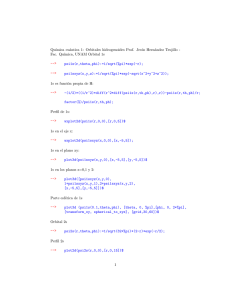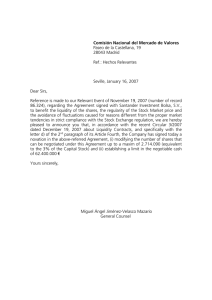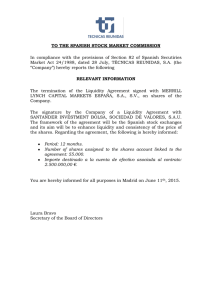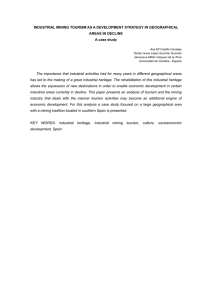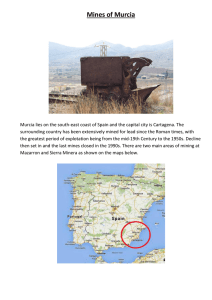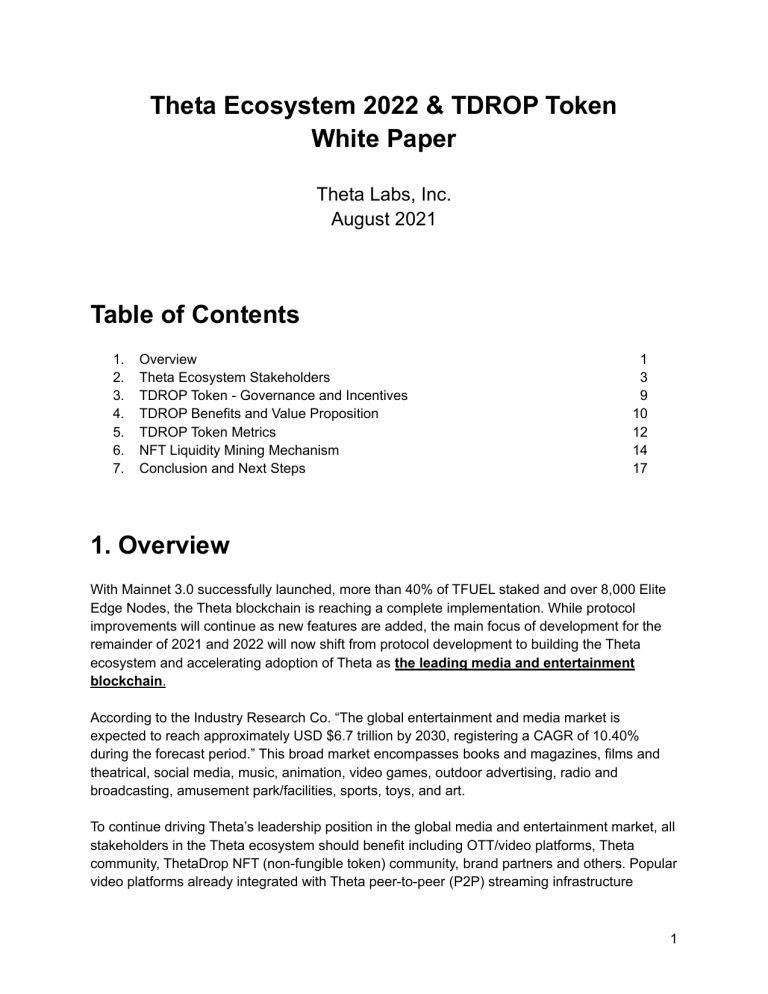
Theta Ecosystem 2022 & TDROP Token White Paper Theta Labs, Inc. August 2021 Table of Contents 1. 2. 3. 4. 5. 6. 7. Overview Theta Ecosystem Stakeholders TDROP Token - Governance and Incentives TDROP Benefits and Value Proposition TDROP Token Metrics NFT Liquidity Mining Mechanism Conclusion and Next Steps 1 3 9 10 12 14 17 1. Overview With Mainnet 3.0 successfully launched, more than 40% of TFUEL staked and over 8,000 Elite Edge Nodes, the Theta blockchain is reaching a complete implementation. While protocol improvements will continue as new features are added, the main focus of development for the remainder of 2021 and 2022 will now shift from protocol development to building the Theta ecosystem and accelerating adoption of Theta as the leading media and entertainment blockchain. According to the Industry Research Co. “The global entertainment and media market is expected to reach approximately USD $6.7 trillion by 2030, registering a CAGR of 10.40% during the forecast period.” This broad market encompasses books and magazines, films and theatrical, social media, music, animation, video games, outdoor advertising, radio and broadcasting, amusement park/facilities, sports, toys, and art. To continue driving Theta’s leadership position in the global media and entertainment market, all stakeholders in the Theta ecosystem should benefit including OTT/video platforms, Theta community, ThetaDrop NFT (non-fungible token) community, brand partners and others. Popular video platforms already integrated with Theta peer-to-peer (P2P) streaming infrastructure 1 include CONtv Anime, World Poker Tour, Cinedigm, GameTalkTalk, MovieBloc, GFUEL, THETA.tv and others. Expanding adoption of Theta’s decentralized video and data delivery is a key focus for 2022 and beyond. Many ongoing strategic discussions with global video and OTT platforms have focused on NFTs and digital collectibles as a new source of revenue in addition to the benefits of decentralized streaming and video delivery. These long-term partnership discussions now include building their NFTs on the Theta NFT smart contract platform, incorporating exclusive NFT drops as part of the live experience for movies and shows across multiple seasons, utilizing Theta P2P infrastructure to incentivize viewers with TFUEL and introducing a fan reward and engagement program. The first Theta global video partner that launches this fully integrated vision at scale will fundamentally change the future of entertainment and gain unmatched competitive advantage. The net result - lower content delivery costs, increased user engagement, more revenues and creator-to-fan touch points. The Theta Edge network will need to expand from video, data delivery and computing to decentralized storage to support this fully integrated vision. With an increased focus on video-on-demand, NFTs and digital collectibles, Theta’s network of Elite Edge nodes are a perfect medium to store and deliver all types of digital media including video, images, music and any digital asset. Theta enterprise validators and guardians will continue to be the core of the Theta network governance and security. The network is now more secure than ever with over 60% of fully diluted Theta supply staked. To successfully execute this strategy, Theta is introducing a new TNT-20 token, TDROP, natively built on Theta blockchain that rewards NFT liquidity mining, provides decentralized governance via TDROP staking, and rewards Theta validators, guardians and Elite Edge node operators. The target launch for TDROP is February 1, 2022. Broadly speaking, the Theta ecosystem can be thought of as the core Theta protocol, built from the ground up for media and entertainment, supporting various applications and stakeholders. The core Theta protocol includes: - Theta layer-1, high performance blockchain governed by Enterprise Validator Nodes and Guardian Nodes Theta Edge Network powered by Edge Nodes around the world relaying decentralized video, data, compute, storage and other functions Theta peer-to-peer video and data delivery supported by micropayments Ethereum compatible RPC interface for DApp interoperability and ease of migration Cross-chain bridges for Theta blockchain users to interact with other blockchains and dapps on Ethereum, Binance Smart Chain, Polygon, and others 2 Theta Ecosystem Stakeholders include: 1. 2. 3. 4. 5. 6. Livestreaming, OTT and video platforms Theta community & Developers ThetaDrop NFT community Live experience and event organizers ThetaSwap DeFi/DEX community Brand and content partners 2. Theta Ecosystem Stakeholders 1. Livestreaming, OTT and Video platforms Decentralized video and data delivery are the backbone of the Theta ecosystem, leveraging underutilized user devices to distribute video and data more efficiently over the decentralized Theta Network. Using the Theta protocol allows video streaming platforms to deliver video to their users at lower cost than traditional Content Delivery Networks (CDNs), and in an augmented form with a CDN the Theta protocol can provide 3 the best of both worlds with lower cost and more reliable stream quality of service. Additionally, user token rewards serve as a powerful engagement mechanism to drive incremental platform viewing times, recurring visits, and revenues. Users are rewarded for sharing their bandwidth to relay video by earning Theta Fuel (TFUEL) tokens for their contributions. Unlike past peer-to-peer protocols, this improved model benefits all stakeholders including the platforms, end users, and Theta token holders that operate the underlying blockchain. The first Theta implementations are in the video delivery space, but the protocol can be used to relay any kind of data. Planned future implementations include game patches, OS updates, and other file downloads that typically have a high number concurrent downloads and are ideally suited to peer-to-peer relaying. Theta Edgecast is the first fully decentralized video streaming DApp that is 100% built on Theta’s native blockchain technology with smart contracts. This technology stack includes the ability to capture video, transcode it in real-time, cache and relay to users globally all through Theta’s peer-to-peer edge network composed of over 100,000 edge nodes today. Recently, Theta Labs received patent application approval for USPTO Application №17/218,245, a technology developed for implementing decentralized digital rights management (DRM) via NFTs in a decentralized network. When it comes to decentralized streaming, content rights holders typically have concerns over their content rights being violated, as they require strong guarantees that a peer-to-peer network won’t be used to infringe on their content rights or that of their artists. Our patented technology addresses this major friction point for content rights holders to stream video on a decentralized network such as Edgecast. By using NFTs to implement decentralized DRM, Theta Network solves this issue for content rights holders in a way that does not require a centralized party to authenticate users each time data is streamed. This opens the door for global content brands to safely bring their videos, movies, and games to Theta’s decentralized data and video delivery network. Expanding global adoption of Theta video and data delivery infrastructure continues to be one of the highest priorities for the project moving into 2022. 2. Theta Community The Theta community includes all the Enterprise validators, Guardians, Edge node operators and third-party developers. Google, Sony, CAA, Blockchain.com, Samsung and other global enterprises supporting Theta as Enterprise Validators have been incredibly important to the success of Theta Network, and helped establish leadership and credibility with corporate partners. This gives Theta a competitive edge to initiate and drive strategic discussions with multinational technology and entertainment firms, and allow these firms to gain experience with Theta blockchain and a deeper understanding of the underlying technology. 4 In the Theta blockchain, Validator Nodes propose and produce new blocks in the chain, while Guardian Nodes seal blocks and act as a check on malicious or otherwise non-functional Validator Nodes. Guardian nodes play important roles to protect the security of the Theta blockchain as they form a second level defense against potential malicious attackers. Community-run Guardian Nodes now number more than 3,000 with over 60% of all Theta tokens staked. This number continues to grow, further increasing Theta blockchain security and defending against any malicious actors. Edge Nodes are a decentralized network for video and data delivery and more general purpose edge computing. As of August 2021, this edge network has grown to over 100,000 nodes, covering all the corners of the world. Running an Edge Node allows users to relay video streams over the Theta Network and process video encoding jobs to earn TFUEL, providing support to all video platforms using the Theta Network. Theta Mainnet 3.0 released in June 2021 introduced two major protocol innovations. First, users are now able to stake TFUEL to an Edge Node to upgrade it to become an Elite Edge Node, enabling “Uptime Mining”, the tokenization of Internet bandwidth and availability. Elite Edge Nodes can earn additional TFUEL through their staked TFUEL, incentivizing a larger, more robust, and more reliable Edge Network. As of August 2021 just two months after launch, more than 40% of all TFUEL tokens are staked to Elite Edge Nodes. Second, a new TFUEL burning mechanism will add a cost for using Theta Edge Network, namely a “network fee” as a balancing force against new TFUEL supply. Since Theta Network launched two years ago we recognized that there is significant value accrued to video platform partners in the form of content delivery network (CDN) cost savings, increased user engagement, and revenues resulting from shifting infrastructure costs to user rewards. With Mainnet 3.0, 100% of all gas fees for running smart contracts and transactions are burned, including all NFT minting and purchase transactions. In the long-run as Theta’s Edge Network becomes more widely adopted, this burn function will reduce the supply of TFUEL. Theta Developer Community Heading into 2022, Theta will be expanding its support for the third-party development community. Key projects are emerging as part of the Theta ecosystem which will further drive forward Theta growth and adoption. These include GPool, ThetaBoard, GuardianMonitor, HarkTV, Minty, ThetaScan, ThetaNext and many others. Upcoming Theta Hackathons will be expanded to further incentivize development with both token/financial support and development assistance from the Theta dev team. To further support the developer ecosystem, a new suite of dev tools is also being built to include: 5 - Ethereum-compatible RPC API suite Metamask integration Support for libraries such as Web3.js and Ether.js Support for smart contract development tools, including Truffle, Hardhat, and Remix This will enable any Ethereum application to be ported over and run seamlessly on Theta blockchain easily and with no or only minor code changes, and more broadly it means that Ethereum developers that are focused on entertainment and media service offerings can pick up Theta easily and start building. Our goal is for Theta development to grow alongside Ethereum and other dev communities, not compete with them. Theta blockchain will offer a widely-used dev environment and compatibility with Ethereum, while being faster and greener than Ethereum by virtue of Theta’s Multi-BFT proof-of-stake consensus — the best of both worlds. With lower fees and higher transaction throughput than Ethereum, Theta also becomes an attractive platform for NFT creation and trading, DeFi applications, or any other smart contract use case. With these new tools available, developers have what they need to create an interoperable Theta ecosystem of dapps and protocols to support decentralized video and data delivery. The Theta / ETH RPC adapter software translates the Theta RPC endpoints into the Ethereum RPC APIs and supports the entire Etherum DApp dev stack including Metamask, Hardhat, Remix, Ether.js, Web3.js, and Truffle Suite. Using this adapter Ethereum DApps like Uniswap, Compound, AAVE etc can be deployed to Theta without any modifications and tap into the growing Theta user and capital base. Furthermore, the ETH RPC adapter greatly simplifies the implementation of a cross-chain bridge connecting the Theta and Ethereum ecosystems. With that, crypto assets like ERC20 tokens, stablecoins and NFTs can freely flow between the two chains. 3. ThetaDrop NFT Community Theta NFTs marked a significant expansion this year with the launch of ThetaDrop, launching first with World Poker Tour, and now featuring other leading global brands including Katy Perry and many top crypto streamers and influencers. ThetaDrop has been a resounding success, in the six weeks after launch more than 100,000 NFTs were sold which generated over $2 million for content creators. The ThetaDrop Marketplace, launched in June 2021, provides a secondary market for users to trade their Theta NFTs and has generated significant volume and value for both creators and collectors. The core vision for Theta NFTs builds on our live streaming, media and entertainment focus. NFTs can enhance the video and livestream experience, commemorate legendary entertainment moments, and unlock exclusive real world experiences. By using the Theta blockchain, the cost to mint NFTs including gas fees is as low as $0.10 and transaction times are ~100x faster than on Ethereum. More importantly, since the Theta 6 protocol is built from the ground up on a proof-of-stake (POS) model it uses a fraction of the electricity and resources making it significantly greener, and more environmentally friendly than other leading platforms. In the future, Theta’s distributed network of more than 8,000 community-run Elite Edge Nodes will support decentralized NFT storage enabling users to truly own and take custody of their NFTs, and not depend on any centralized platform for media data storage. Cross-chain bridge between Theta Network, Ethereum and others will enable seamless NFT transfer and transactions across networks, so users can take their NFTs with them wherever they want to. True decentralized ownership of digital assets. Moving into 2022, exploring new and innovative application areas for NFTs will become an important focus, particularly around live streaming, live commerce and the live experience. 4. Live Experience and Event Organizers With pandemic lockdowns slowly being lifted, we are seeing the re-emergence of live events as a key entertainment form. NFTs came to the forefront of the blockchain space at a time when live events were shut down across the world. Fans and artists still craved connectivity to each other and NFTs blossomed. We project that in the coming years we will see the widespread integration and adoption of NFTs combined with live events and exclusive in-person experiences. There are also massive opportunities behind the scenes for live events in the ticketing and authentication space, for example. Theta recently was awarded a patent for this technology to use NFTs for decentralized DRM (digital rights management). This technology has important applications for managing rights across a number of domains including, for example, live performances, concerts, and other ticketed events that require authentication, which can now be managed via an NFT that provides cryptographically proven digital ownership for the user, something which cannot be taken from them. Additionally, these “virtual ticket” NFTs can be collected and grant owners future benefits including airdropped items, special one-of-a-kind merchandise, backstage passes, exclusive products and more. This enables a full fan lifecycle management system that continues beyond a particular event and into all future fan touchpoints and engagement. For brand owners, content creators, and IP holders this opens a whole world of opportunities to drive new revenue streams and engagement with residual revenues. 7 5. ThetaSwap DeFi/DEX Community The initial version of ThetaSwap launched in February 2021 as the first decentralized non-custodial exchange on Theta blockchain. ThetaSwap uses an open-source smart contract system based on Automated Market Maker logic similar to that of UniSwap. It allows users to exchange their newly-created TNT-20 tokens built on Theta blockchain in a trustless, non-custodial way. From streamers issuing loyalty tokens to their fans, to pools and DAOs to fund entertainment and media ventures, this creates many exciting new ways to use Theta blockchain. We expect the launch of media/entertainment tokens to be a major theme for 2022 and beyond, as everyone from the smallest streamer to the largest Hollywood studio looks for new ways to monetize their content in a seamless and decentralized way. With the release of new Theta development tools this year such as an Ethereum-compatible RPC API suite, smart contract development tools, and integrations with Truffle Suite and Metamask, DeFi applications will become even easier to build from scratch on Theta or port over from Ethereum. Theta version v3.1.0, released in July 2021 along with the Theta RPC adaptor project, will provide support for the Ethereum RPC API similar to Binance Smart Chain and Polygon. Ethereum dapps that are ported over to Theta can now use the same API calls to interact with Theta blockchain. This upgrade also paves the way for cross-chain bridge development since the Theta and Ethereum blockchains can share the same set of APIs. It is exciting to see the Theta community use their development skills to build Theta-compatible versions of dapps, either independently or as part of the next iterations of Theta Hackathon coming soon. Additionally, the Theta team will continue to work on several demo projects to port popular Ethereum DApps (ex. Uniswap V2, including both the underlying smart contracts and the user-facing frontend) to Theta blockchain. 6. Brand and Content Partners Theta has featured premium content from Hollywood studios like Lionsgate, MGM, Jukin Media and Cinedigm as part of a larger strategy to innovate and drive new monetization models in the entertainment space. Major media companies have rightly moved to digital-first strategies in the last few years, and the next step is for media monetization to undergo its own digital transformation. That started with Theta token rewards for users that participate in video streaming and sharing, and is now expanding to unique non-fungible digital assets (NFTs) as a way for entertainment companies to generate new, incremental revenue streams from their most loyal fans. Imagine if film and TV buffs could own a piece of all-time classic characters or moments from their favorite shows and movies or a part of an upcoming blockbuster? It’s an untapped market in the fast-growing NFT space and the media and entertainment industry today is ready to lead the mainstream adoption for NFTs and blockchain technologies. 8 3. TDROP Token - Governance and Incentives As ThetaDrop platform continues to add premium brand partners like WPT and Katy Perry, NFT sales and trading volumes have grown substantially month over month. In order to increase the rate of adoption and liquidity of ThetaDrop NFT Marketplace, a new TNT-20 token, TDROP, will be created to incentivize usage through “NFT Liquidity Mining” and serve as the governance token for the ThetaDrop platform. In the future when decentralized storage of NFTs is implemented on the Theta blockchain, Elite Edge Node operators will be rewarded with 1% of the gross sales of NFTs supported by their edge node across both the primary and secondary markets. 1. NFT Liquidity Mining: TDROP tokens will be earned by users each time they make a primary or secondary purchase using TFUEL on ThetaDrop NFT Marketplace or through a 3rd-party NFT Dapp built on the NFT marketplace smart contract. It can be thought of as ‘mining’ TDROP by providing liquidity to the Theta NFT Marketplace. This mechanism is similar to how many DeFi protocols bootstrapped their own liquidity. It incentivizes early adopters of ThetaDrop to provide liquidity which enhances price discovery, improves trading volumes, and drives more user growth and adoption. ThetaDrop users who hold a balance of TDROP will earn VIP benefits including early or exclusive access to NFTs, limited edition packs, unique offline perks and more. 9 The NFT liquidity mining mechanism has been carefully designed. The main goals are to improve the marketplace liquidity and disincentivize wash trading. Our approach is described in detail in the “NFT Liquidity Mining Mechanism” section. At a high-level, the incentive structure motivates typical users to make purchases, which improves the liquidity of the NFT marketplace. Meanwhile, the design guarantees that over time the cost of wash trading exceeds the mining reward, regardless of the ratio of TFUEL and TDROP and disincentivizes frequent transactions of the same NFT by implementing a “reward cool-down” mechanism. 2. More TFUEL Burning: As more NFTs are transacted on the Theta blockchain, more TFUEL is burned and the amount of TFUEL in circulation decreases accordingly. This in turn leads to greater THETA staking rewards and greater Theta network security. 3. On-Chain Governance: TDROP will also serve as the governance token for ThetaDrop and the NFT Marketplace. TDROP holders can stake their tokens to gain voting rights for proposed changes to ThetaDrop. Each user’s voting rights for a given proposal will be equal to their share of staked TDROP as a percentage of total TDROP staked. The first TDROP vote proposal is expected to be the earning rate of TDROP for liquidity miners, subject to change. As the voting process progresses and stabilizes, TDROP holders will be responsible for creating new proposals to be voted on. Voting on proposals are expected to initially occur on a quarterly basis. Similar to the governance mechanism of prominent DeFi projects like Compound and Uniswap, TDROP governance voting will be conducted fully on-chain through smart contract calls. These community proposals will also serve as the testbed for community governance features to be implemented on the Theta blockchain itself, to be voted on by holders of the Theta token. 4. TDROP Benefits and Value Proposition The addition of the TDROP token will benefit all Theta stakeholders and contribute to the continued adoption and growth of Theta Network. TDROP benefits to stakeholders include: 1. Existing video and OTT streaming platforms - while NFTs garnered media attention in early 2021, Theta had already launched custom NFTs as part of Theta.tv streaming platform in late 2020 along with the launch of generalized smart contracts. These digital NFT emojis and badges on Theta.tv greatly increased user engagement with content creators and streamers, leading to higher viewing times and user retention rates. These case studies have been incredibly valuable in partnership conversations with leading video, streaming and OTT platforms. 10 The use case is not only about decreasing CDN costs with the addition of a peer-to-peer decentralized streaming infrastructure but also significantly increasing user engagement and monetization through NFTs, collectibles and earned TFUEL rewards for bandwidth sharing. These additional benefits are business critical in the highly competitive streaming and video markets, and puts Theta in an even better position to capitalize on these opportunities. The addition of the TDROP token only accelerates the monetization and liquidity of these NFTs especially when implemented into an existing video platform. 2. Theta community & Developers - Theta enterprise validators and guardians will be rewarded with TDROP over a 18-month period for providing continued support, governance and network security of the core Theta protocol. When decentralized storage is implemented, Elite Edge Node operators will be rewarded with 1% of the gross sales of NFTs supported by their node across the primary and secondary markets. This is a critical step in decentralized ownership of digital assets, and enabling NFT owners to take them wherever they want. Any third-party developer that builds NFT platforms and marketplaces on top of Theta blockchain will also be eligible to utilize TDROP liquidity mining to reward their users to engage, purchase and transact NFTs. 3. ThetaDrop community - ThetaDrop users will have the opportunity to earn TDROP with every NFT transaction, qualify for various VIP tiers giving them exclusive access to drops and other benefits. More importantly, with the added transparency and transaction volume on ThetaDrop even more TFUEL will be burned with every new transaction on the Theta network. 4. Live experience and event organizers - Theta NFTs are leading the way for incredible live experiences with NFTs representing World Poker Tour tournament moments and Katy Perry’s upcoming Las Vegas residency. Theta NFTs have also been used for more personal live experiences like 1-on-1 meetings with Theta team and private events such as Crazy4Cryptos Thailand crypto event. TDROP tokens will enable all these and give a reason for previously “siloed” fan base to cross-promote and become even more successful. Exclusive ThetaDrop VIPs will give TDROP holders once in a lifetime real world experiences such as back-stage meet and greet with their favorite celebrities or an exclusive seat at the next tournament or fight. 5. ThetaSwap community - upon launch TDROP tokens will be supported, liquidity pools setup and tradeable on ThetaSwap DEX. This will become an important launch pad for increased utilization of ThetaSwap and positioning it at the intersection of Theta’s video delivery, NFT and live experience platforms. 6. Brand and content partners - NFTs have quickly captured the interest of many film studios, talent agencies, and branded IP owners. This has become a great starting point for Theta’s discussions with these partners and expanded into more strategic collaboration by incorporating Theta decentralized video delivery infrastructure. Our ultimate brand partnership would include an exclusive live stream of the event on the 11 Theta platform powered by Theta P2P streaming technology enabling fans to earn TFUEL for sharing bandwidth, real-time NFT drops and exclusive VIP benefits to TDROP holders. For example, a new blockbuster movie could 1) live premiere on a platform like Netflix, Amazon Prime or Disney+ powered by Theta streaming infrastructure, 2) fans receive once in a lifetime NFTs for amplifying their experience in social platforms, 3) receive future invitations to events and 4) VIP TDROP holders get a chance to attend the Hollywood red carpet premiere in-person. Any other film studio would love to reach this same engaged and targeted audience for their next movie. 5. TDROP Token Metrics TDROP will have a fixed supply of 20,000,000,000 (twenty billion) tokens with a target launch on February 1, 2022. The breakdown of TDROP token allocation is as follows: 30% - Earned by NFT Liquidity Mining on ThetaDrop platform (4-year period) 20% - Staking rewards for decentralized governance (4-year period) 20% - Rewards for THETA validators and guardians including delegated stakers (18-month vesting, 1/6th per quarter) 20% - Theta Labs dev team (18-month vesting, 1/6th per quarter) 10% - Reserve for Theta marketing, advisors, partners (not vested) The anticipated amount of TDROP in circulation is shown in the graph and detailed in the table below. 12 TDROP for NFT Liquidity Mining A total of 6 Billion TDROP (30% of total supply) is allocated over a 4-year period for NFT liquidity mining, earned by users that transact using TFUEL on ThetaDrop NFT Marketplace or through 3rd-party NFT Dapps built on the Theta blockchain, across both primary and secondary markets. For illustration purposes in the table above, a linear liquidity mining is used; however, the actual TDROP earning formula will be a function of multiple variables as detailed in the “NFT Liquidity Mining Mechanism” section. TDROP Governance staking rewards A total of 4 Billion TDROP (20% of total supply) is allocated over a 4-year period as rewards for staking TDROP, which also allows users to participate in the decentralized governance of the network. Each year 1 Billion TDROP will be distributed proportionally to all TDROP stakers. At the end of the 4-year period, the community can propose and vote on possibly extending this. TDROP for THETA validators and guardians On February 1, 2022, 1.33 Billion TDROP (or ⅓ of the allocated 4 Billion) will be distributed proportionally to all THETA validator and guardian stakers. An average amount of THETA staked between August 1, 2021 and February 1, 2022 will be used for reward calculation. For example, if a guardian stakes on average 100,000 THETA during those 6 months, then they will receive 100,000 / total ave THETA staked x 1.33 Billion TDROP. Thereafter, 666.6 Million TDROP (or ⅙ of the allocated 4 Billion) will be distributed proportionally to stakers each quarter, ie. on May 1, 2022, August 1, 2022, November 1, 2022 and ending on February 1, 2023. TDROP Allocation for Theta Dev team A total of 4 Billion TDROP (20% of total supply) is allocated to the Theta development team with the same vesting period as for THETA validators and guardians. The Theta development team will be incentivised to continue developing the platform. On February 1, 2022, 1.33 Billion 13 TDROP will become vested and distributed to the team, and 666.6 Million TDROP each quarter thereafter through February 1, 2023. Theta Reserve A total of 2 Billion TDROP (10% of total supply) is reserved to Theta Labs for marketing purposes, advisors, partners and other strategic development purposes. These tokens are not vested. 6. NFT Liquidity Mining Mechanism The NFT liquidity mining mechanism has been carefully designed. The goal is to improve the marketplace liquidity and disincentivize wash trading which could significantly degrade user experience. Reward Mechanism Design Formula (1-3) below details an NFT liquidity mining mechanism that achieves the above goals. At a high-level, by providing TDROP rewards, the incentive structure motivates real users to make purchases, which in turn improves the liquidity of the NFT marketplace. Meanwhile, it guarantees that eventually, the cost of wash trading exceeds the mining reward, regardless of the ratio of TFUEL and TDROP. Furthermore, it disincentivizes frequent transacting of the same NFT through the “reward cool-down” mechanism, which incentivises longer hold periods. We believe these two properties are critical to prevent wash trading. Given an NFT, for its i-th trade on the Marketplace using TFUEL, the amount of TDROP liquidity mining reward is given by the following formula. The NFT buyer will receive Ri amount of TDROP tokens for providing the liquidity: (1) (2) (3) In the formulas above, vi is the trading value of the NFT (in terms of TFUEL), v*i-1 is the highest trading value of the NFT in its previous (i-1) trades. hi and hi-1 are the block height of the current 14 (i.e., i-th) and last trade, respectively. Rmax, α, ε, and ω are constants. Potentially they can be adjusted through on-chain governance discussed later in this section. In simpler terms, these formulas describe that if an NFT is trading at a value lower than the historical high, the mining reward is a small number ε. Otherwise, the mining reward depends on two factors, namely the value increase (vi - v*i-1), and the time gap between the current and the previous trade. As a hypothetical example, assume Rmax = 50.0, α = 2.0, ε = 1.0 , ω = 0.05. We also assume that v*i-1 = 10 TFUEL, and the current trade swaps the NFT for vi = 60 TFUEL. The last trade of the NFT happened at block height hi-1 = 6000, and the current height hi = 6020. Then, Ri = 2 ⋅ log2(60 - 10 + 1) ⋅ (1 - 1/(0.05 (6020 - 6000) + 1)) = 5.67 TDROP. This means the buyer will mine 5.67 TDROP after this trade is confirmed on chain. Wash Trading Mitigation Clearly this reward mechanism can improve the liquidity of the secondary market, as it provides a strong incentive to NFT buyers. On the other hand, it can effectively discourage wash trading. To see why this is the case, note that for wash traders, there is a TFUEL cost associated with with each trade: (4) In the above formula, Ci is the cost of the i-th trade. It consists of two parts, β⋅ vi represents the marketplace charge (e.g. β = 0.1 means marketplace charges 10% of the sale), and γ stands for the TFUEL gas cost. Note that the mining reward Ri is proportional to the logarithm of the difference between the current and the highest trade value in the past. On the other hand, the cost Ci depends linearly on the current trade value. Intuitively speaking, since a linear function grows exponentially faster than a logarithm function, for a given NFT, the cost of wash trade would eventually exceed the mining reward. Below we prove that this is the case regardless of the value of TFUEL and TDROP: Theorem 1. For a given NFT, the ratio between the total wash trade reward and cost approaches zero as the number of trades approaches infinity, i.e. Proof. First, by setting proper parameters, we can ensure the TFUEL gas cost γ in Formula (4) exceeds the minimal possible reward ε in Formula (1). Thus, to yield positive gains, an attacker needs to continue to raise the purchase value. Otherwise, each purchase mines ε, which is not even enough to cover the gas cost. Hence, we have 𝑣𝑖 − 𝑣𝑖−1 ≥ γ. 15 Meanwhile, we note that in Formula (1), function g(hi) is bounded by 1, hence the reward 𝑅𝑖can * be bounded by 𝑅𝑖 ≤ α 𝑙𝑜𝑔2(𝑣𝑖 − 𝑣𝑖−1 + 1) ≤ α 𝑙𝑜𝑔2(𝑣𝑖 + 1). We thus can bound the total reward by where 𝑥 = (𝑣1 + 𝑣2 +... + 𝑣𝑛)/𝑛. On the other hand, the total cost can be expressed as We thus have the following Recall that in the beginning of the proof, we have shown that 𝑣𝑖 − 𝑣𝑖−1 ≥ γ. This means 𝑣𝑖 ≥ 𝑖 · γ . Thus, 𝑥 = (𝑣1 + 𝑣2 +... + 𝑣𝑛)/𝑛 ≥ (1 + 2 + 3 +... + 𝑛)γ/𝑛 = 𝑛γ/2. Therefore, as 𝑛 approaches infinity, 𝑥also approaches infinity. Hence, we can conclude that Theorem 1 is thus proved. ⟏ It is important to note that since the ratio of total reward and total cost approaches zero, regardless of the the value of TFUEL and TDROP, the cost eventually will exceed the reward, rendering the wash trading unprofitable. We note that for real buyers, the cost Ci is already compensated by the inherent value of the purchased NFT, since a real user only buys an NFT when he or she considers it fairly valued. Thus, unlike the wash trading scenario, to real users, the mined TDROP tokens are always an added benefit. 16 Mining Reward Cool-Down To further disincentivize wash trading, the function g(hi) in the mining reward Formula (3) incorporates the “reward cool-down” mechanism, which demotivates frequent transacting of the same NFT: Basically g(hi) is a monotonically increasing function of the time gap (ℎ𝑖 − ℎ𝑖−1)between two consecutive trades of the same NFT. It ensures that a smaller time gap between two subsequent trades results in lower rewards. Conversely, a longer time gap between subsequent trades increases the mining reward. For example, in the hypothetical example above, if other variables stay the same, but the current trade happens at block height 6500 instead of 6020, then Ri = 2 ⋅ log2(60 - 10 + 1) ⋅ (1 - 1/(0.05 (6500 - 6000) + 1)) = 10.91 TDROP. Thus, with the same amount of TFUEL paid for the NFT, frequent trades reduce the mining reward, which is disadvantageous to wash traders. For typical users, this mechanism provides incentives for them to purchase NFTs listed for sale for a long time and further improves the liquidity of the market. Some may argue that this could discourage purchases as deliberately waiting could increase the potential reward. However, we note that g(hi) saturates rather quickly as the time gap increases. After some reasonable amount of time, the mining reward will not increase much with the time gap. So, typical users will not purposely wait to purchase just for this small increased reward. Whitelisting NFTs for TDROP mining Note that the TDROP mining reward is only enabled for trading against TFUEL. Trading using stable coins or other currencies does not generate mining rewards. Additionally, NFTs that are eligible for liquidity mining will be whitelisted. This is similar to Uniswap and Curve, where liquidity mining is turned on only for a subset of liquidity pools. The whitelist is determined initially by ThetaDrop, and later through on-chain decentralized governance mechanisms. The purpose of whitelisting is to prevent attackers from creating and wash-trading arbitrary NFTs to grind for TDROP rewards. 7. Conclusion and Next Steps The primary focus of Theta development moving into 2022 and beyond will be to accelerate the growth and adoption of the Theta ecosystem and development community. Our fully integrated 17 vision for global media and entertainment companies is to create once in a lifetime experiences using Theta P2P streaming infrastructure to incentivize viewers, Theta NFTs to enhance livestreams, live experiences, and the Theta network of Edge Nodes to relay and store these digital media and NFTs. The result is lower content delivery costs, increased user engagement, more revenues and creator-to-fan touch points. With staked THETA and TFUEL at all time highs of 60% and 40% respectively, we see more momentum than ever in support of the Theta protocol. The addition of TDROP will drive liquidity and value in ThetaDrop market which in turn fuels the value proposition for creators, fans, and platforms to implement Theta NFTs. These digital collectibles and assets provide a powerful new feature to motivate global video platforms to fully integrate Theta blockchain as a core part of their infrastructure. Built-in TDROP incentive mechanisms for Theta stakers, Edge Node operators, and ThetaDrop users ensure that all stakeholders in the Theta ecosystem benefit from the introduction of the new token. In addition to ThetaSwap and ThetaDrop as pillars of the Theta ecosystem, community applications being built on Theta will drive further usage of Theta blockchain, leading to increased transaction counts and TFUEL usage and burning. Enhanced developer tools such as the Theta RPC adapter project will also pave the way for further development of Theta community projects and cross-chain bridge development with Ethereum, BSC, Polygon, and other blockchains. The Theta team will continue to support the community with Theta Hackathons, financial support, and demo projects to bring popular Ethereum DApps to Theta blockchain. The next step in Theta’s development vision starts early in August 2021 with the release of the full featured Theta/ETH RPC adapter, enabling the next generation of applications in the Theta ecosystem. For new and existing Theta stakers on validator and guardian nodes, the period to stake THETA tokens to earn TDROP begins on August 1st, 2021, leading into the initial release of the TDROP token on February 1st, 2022. 18
